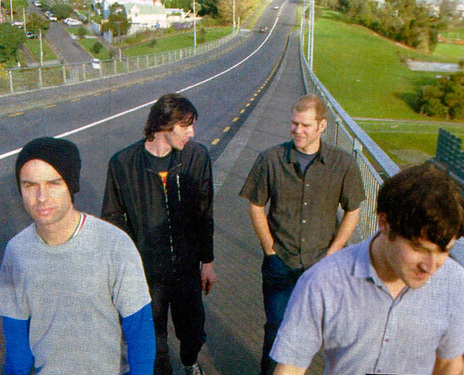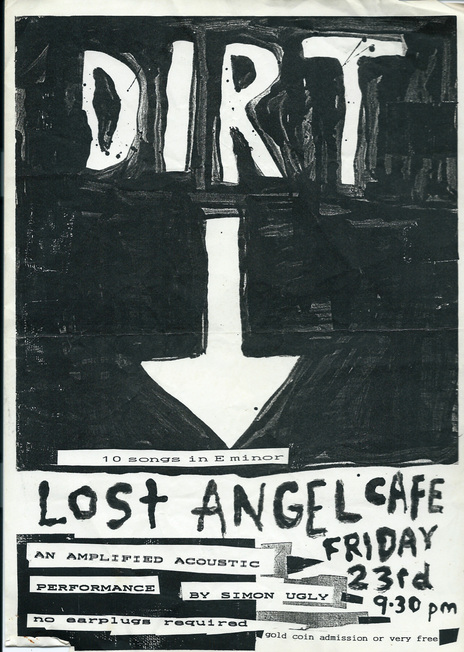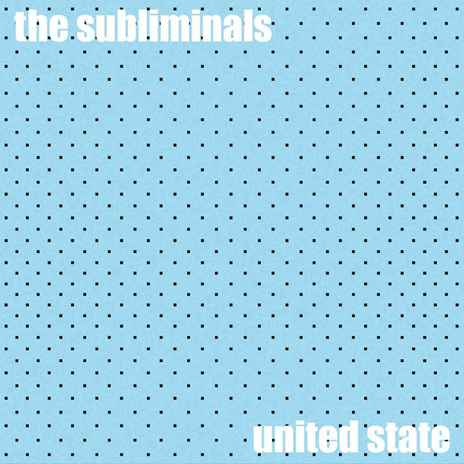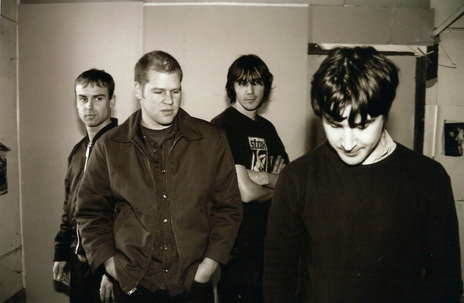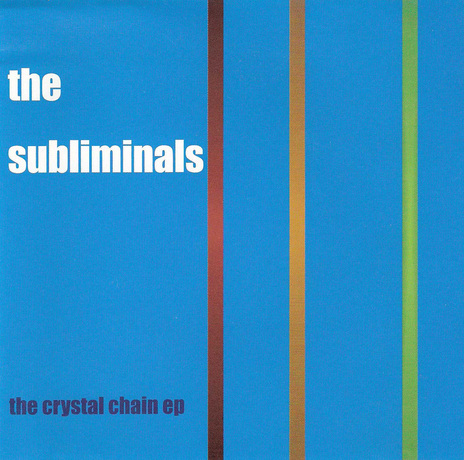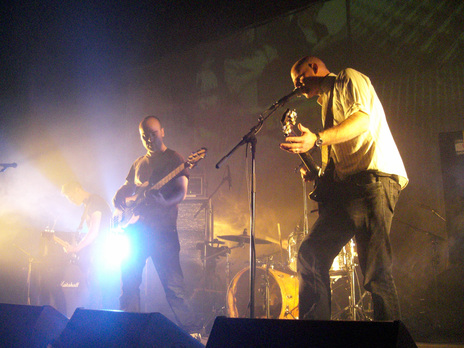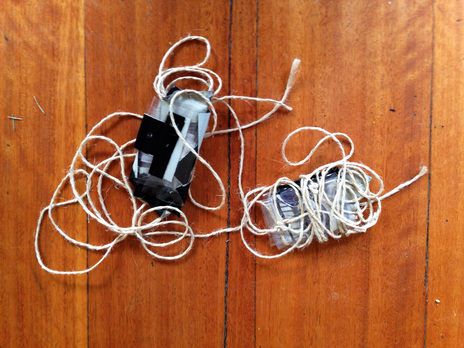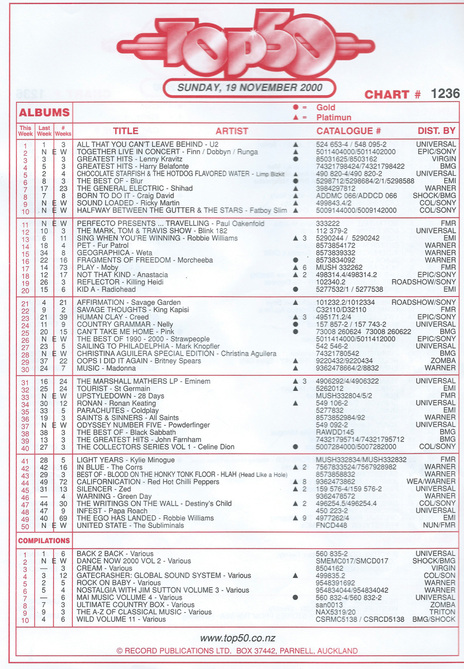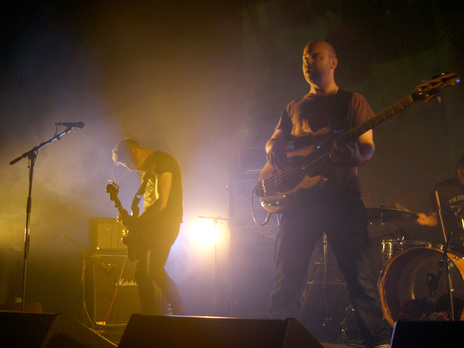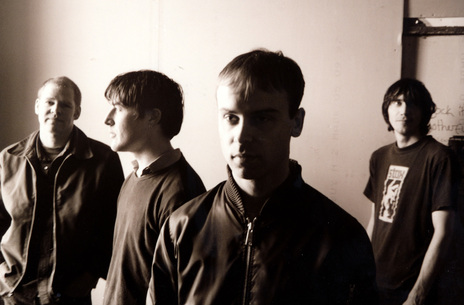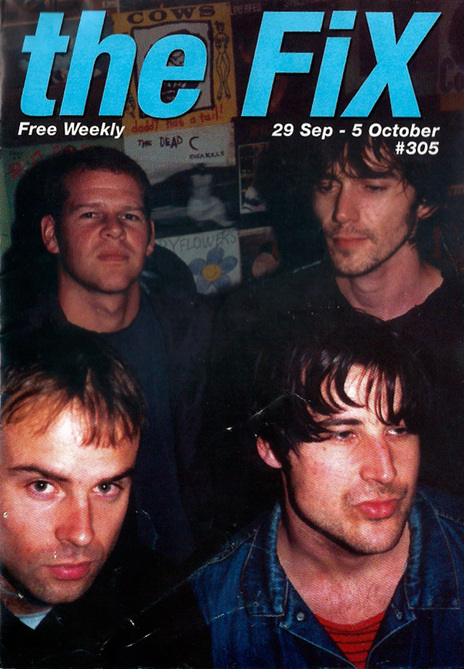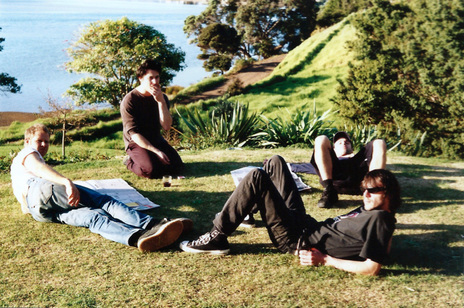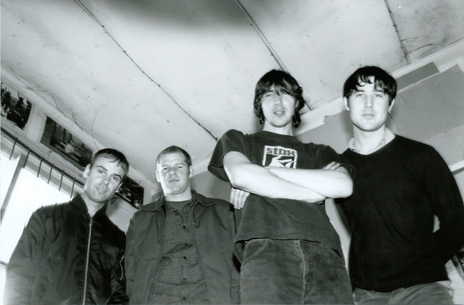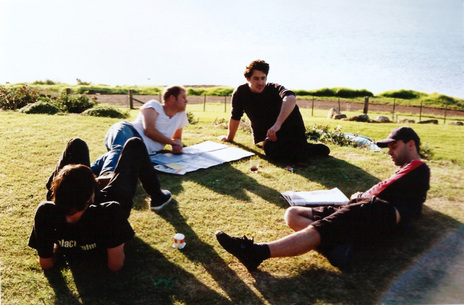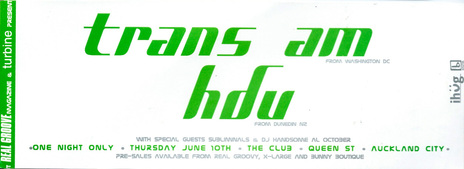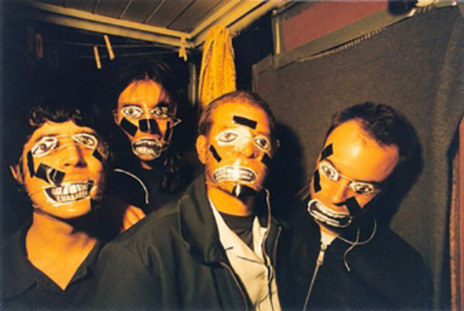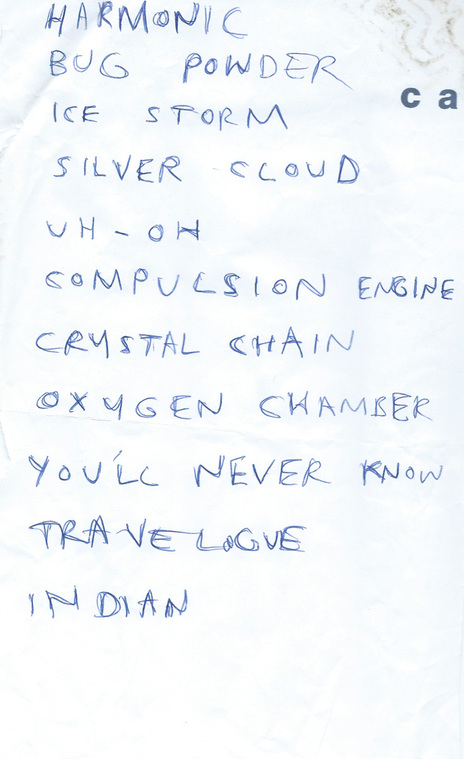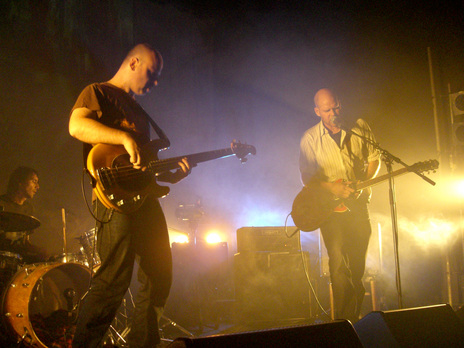Maclaren and Reay were old friends from their Christchurch days. They first collaborated in the early 90s when, at the behest of The Bats’ Paul Kean (formerly of Toy Love), they entered an RDU live songwriting competition. With a single practice the night before, the duo were surprised when they prevailed, winning themselves T-shirts and three plastic cups of flat beer. Coincidently, Kean was also a judge.
It wasn't long before Reay was feeding back to Moran's rhythmic accompaniment.
While hanging out at Hat’s radio show Freak The Sheep at Auckland student radio station 95bFM, Reay met Hasselhoff Experiment drummer Brendan Moran. The two bonded with the aid of some affordable social lubrication at the nearby Shadows Bar and it wasn't long before Reay was feeding back to Moran's rhythmic accompaniment.
Reay was impressed with Moran’s style and feel and realising the value of a great drummer, became determined to form a unit based around this nucleus. Now at a loose end since the dissolution of Loves Ugly Children earlier in the year and an acquaintance of both Reay and Moran, Maclaren was an obvious candidate. The group finally crystallised with the addition of Hat's flatmate, former Bressa Creeting Cake bassist Jared Johanson. The nascent Subliminals took form.
Compulsion Engine
From the beginning there was an emphasis on simplicity. Small ideas were emphasised through guitar interplay while Johanson's strong rhythmic and harmonic sensibilities provided the link to Moran's effortless motorik grooves. Many of the band’s initial efforts were sprawling free-form jams with minimal oversight, each member finding their natural place in the sound. While not always successful, this method proved the cornerstone of The Subliminals’ creative process.
Reay and Maclaren shared an appreciation of the Krautrock stylings of Neu and Moran was amenable to the concepts they were putting forward: not only did it place great emphasis on the role of the drums, it called for a significantly different approach to what he was doing in The Hasselhoff Experiment. On the other hand, Johanson, late to arrive at the party, was largely unfamiliar with their reference points but picked up on the rhythmic focus and hypnotic repetition.
Despite the strong conceptual backbone, the music largely developed organically in the practice room. The Subliminals was a logical name for the band.
Reay and Maclaren would meet to work on the guitar arrangements in a process the former described as “error correction”.
Away from the group, Reay and Maclaren would meet to work on the guitar arrangements in a process the former described as “error correction”. Reay had never really considered himself a “musician”, noting “I’m the one who loses count” and he didn't really feel capable of playing riffs. This suited Maclaren, who was motivated to make something freer and less “rockist” than his previous band.
There was a strong element of mutual appreciation between the two guitarists: Reay considered Maclaren a more accomplished player and in turn Maclaren relied on Reay to provide colour – or as he confessed to NZ Musician, “If I play something quite plain and robotic I can always guarantee on Steve doing something quite fluid and mental on top.”
Between them they formed the crucial and distinctive tonal basis of the band, strongly shaped by Reay's idiosyncratic use of wah (once uncharitably described to him as sounding like “strangling a cat”) and Maclaren's often Middle Eastern infused melodic lines.
Speed of Sound
Momentum was quickly established and The Subliminals made their first public appearance after a handful of jams. They debuted opening for the recently reconstituted Headless Chickens at Gasoline Alley on Stanley St. A handful of shows followed before interest turned to recording. But first financing had to be organised.
Paul McKessar, then general manager of Flying Nun, recounts the pitch meeting. “The first thing I remember is Simon Maclaren and Stephen Reay in my office at Flying Nun basically telling me that I was going to fund and release The Crystal Chain EP.”
While Reay insists their approach wasn't quite so heavy handed, McKessar remembers the incident fondly and was open to their proposal. “I already knew all four members of the band in any case and the recording was certainly an encouraging start. It was the kind of music we were all into at the time and I loved the way Brendan especially could shift from the wild rock'n'roll of Hasselhoff to this motorik beat in the Subliminals. I don't know that we expected it to be popular but they had good songs and a brilliant drummer, that's usually enough to begin with.”
The Crystal Chain
The Crystal Chain EP was recorded over two or three days in 1999 in a Kaukapakapa cowshed by Dale Cotton, best known for his work with HDU. The cowshed itself was in “original condition” and the band had to first remove equal parts straw and animal faeces before they could begin. The idea behind the choice of locations was to free the band from the usual time restraints of commercial facilities and produce a relaxed atmosphere with a sense of occasion.
Johanson, in particular, found the approach and experience refreshing in comparison to previous projects. “In general we did not practise a lot as a band – we would practise when required but it was not a weekly thing. Before the recordings we put a bit of extra time in but certainly not as much as I have experienced in other bands. If anything there was a lot of material that was perhaps under-developed and a lot of songs evolved organically when we were recording them.”
The result was a six track EP that sounded remarkably developed.
The result was a six track EP that sounded remarkably developed. The title track exemplified the band’s approach – starting life as a nearly 30 minute jam that was edited down to a more listener-friendly duration. The calm openness of this track was immediately contrasted by the bombast of 'Travelogue' and then the angular melodic frenzy of 'Bug Powder'. The EP was diverse and by this stage The Subliminals sound had evolved beyond purely instrumental, with Maclaren and Reay adding vocals to three of the six tracks. The end results constituted an extremely strong debut.
Upon release of the EP later that year, these qualities did not go unnoticed. NZ Herald’s Russell Baillie described it as, “the most alarmingly good thing the seemingly resurgent Flying Nun label had put out in some time” and the EP garnered The Subliminals a nomination for the bNet’s Best Rock Release (which was ultimately won by Shihad for Blue Light Disco).
The Crystal Chain sold solidly both locally and internationally via Flying Nun’s mail order service.
The release was also accompanied by a video for the title track directed by Marc Swadel. Shot on 16mm in a backyard, the video made extensive use of in-camera effects and dual exposures in what Swadel describes as “a triumph of style over budget” thus providing an excellent visual accompaniment to The Subliminals’ unique music.
Radiance
While the Subliminals could not be described as a band that toured heavily or had an overbearing live presence, at their peak they never struggled to fill the King’s Arms in Auckland. Much like their practices, live performances often became freeform affairs emphasising the hypnotic and repetitive minimalism of the band’s music. This approach could produce mind-altering results and audience reactions often surprised the band.
One such incident at a bFM live-to-air is permanently etched into folklore and even more so in Johanson’s memory: “Packed crowd, live to air, fairly intense atmosphere capped off by a woman invading the stage while we were playing, she was hurling abuse at students in general due to her belief that one of them had stolen her umbrella.” It got worse. “It’s all because of you!” she insisted on confiding to him at close range, over and over, while he attempted to remain composed and continue playing bass. “Cue wrestling match involving band members and stagehands in an attempt to remove her from the stage.” Sadly, said umbrella was never recovered.
Aside from their own shows, The Subliminals were also often invited to open for notable local and international acts such as Dimmer, HDU and Stereolab. The support slot for New York post-rock pioneers Trans Am at what is now the White House strip club on Queens St was a stand out gig. Having recently completed The Crystal Chain EP, the band were flattered by the enthusiastic crowd response and appreciated the unique venue. The headliners were particularly impressed by The Subliminals and reportedly often played the EP before taking to the stage at future shows.
United State
The full-length release United State was recorded in a manner similar to The Crystal Chain EP. Retaining the same approach, the venue was shifted to a beach house in Northland with recording duties now handled by Dunedin based engineer and producer Tex Houston. The drums were set up in the basement, with Johanson, Maclaren and Reay connecting to their respective amplifiers, distributed throughout the building, via lengthy cable runs so that the band could play together but with maximum isolation.
The fundamental tracking took place over three days including set up and pack down, not to mention loading in a 2” 24-track tape machine that involved some considerable sweating and all five people to lift it. Opening track ‘Radiance’ was jammed for the first time during the initial set up before being recorded in earnest the following day.
At times, the environment proved challenging. The house was solar powered and Johanson siphoned petrol from his car to keep the generator going at night.
With Flying Nun in the process of merging with Festival Mushroom, they had vacated their Queen St office with a few weeks remaining on the lease. The Subliminals took advantage of this fact, occupying the space to complete a small number of overdubs (including Theremin work from Alan Holt) and to mix the album.
Maclaren was keen to use a work by prominent UK artist Bridget Riley as the cover for United State. McKessar was somewhat alarmed: the work in question was Riley’s signature op art piece and he rightly feared legal repercussions. Furthermore there was a very limited budget. So he wrote a very polite letter to the artist seeking permission. The Internet was still in its infancy so a letter was still a piece of paper transported to the other side of the world and consequently quite slow. Time passed and no reply was forthcoming.
United State was another step up from what the band had achieved with The Crystal Chain EP.
With the release date looming, perspiration began to accumulate until designer John Pitcairn made a suggestion: by altering the background colour and changing the little circles to squares he felt the copyright issues could be successfully sidestepped. To McKessar’s relief, everyone agreed the new design looked great and it was adopted as the cover and the album released. A small time later, McKessar received a reply from Riley’s assistant, generously granting permission.
United State was another step up from what the band had achieved with The Crystal Chain EP. Critically, the album was not damned by faint praise with Grant Smithies describing it as “...the best local rock album in years” in his Sunday Star Times review. Likewise Russell Baillie remarked that United State “neatly capitalises on the promise of that earlier release” and proved “a real mindbender.”
Uh-oh
Some time in late 2001, The Subliminals quietly faded away. Why this was is not abundantly clear. The band was still popular, their recorded work well received and no one had died. Maclaren who is still “very fond of the Subs” is at a loss to explain it. Moran jokingly offers “bickering songwriters” as a reason before glancing at Reay, who just laughs. Johanson is more philosophical, suggesting that all the typical and clichéd things that happen to bands happened to The Subliminals, albeit over the relatively brief two year period that the band existed.
However Reay, ever the pragmatist, provided crucial insight in his statement to NZ Musician in 2000: “When it stops working, we'll stop doing it.” His more recent reflection describes The Subliminals as “an accident, a beautiful accident” and it’s easy to see what he means. The band was always heavily reliant on the cohesion of the four members but its strength was also its vulnerability with any disruption threatening the essential and delicate synergy that made the music potent.
But clearly no acrimony remains. The Subliminals reunited in 2011 for the 30th Anniversary Nunfest. Watching the band play, the intervening decade melted away with the band sounding as fresh, cohesive and coherent as they ever had. The simplistic and hypnotic nature of their music has not dated the sound. Despite their brevity, The Subliminals stamped an indelible high-water mark on the landscape of New Zealand music.
